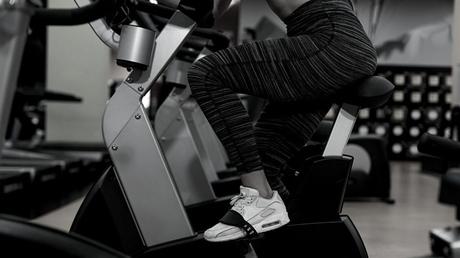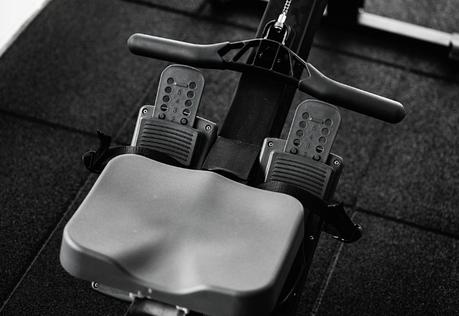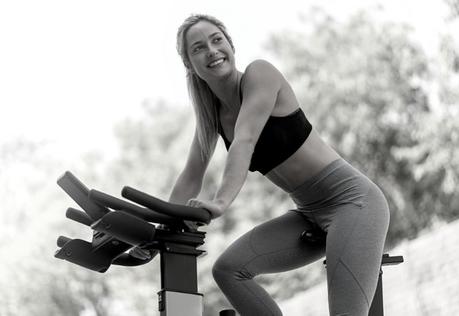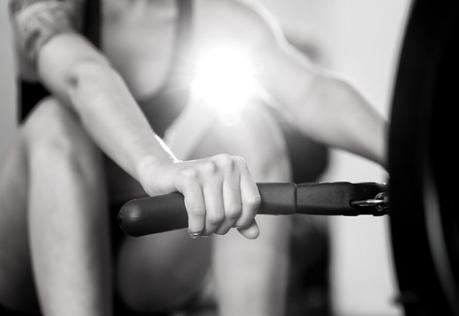The rowing machine and stationary bike are two of the most popular cardio machines in the gym. But which one is best for you? Read on as we highlight the key differences and who each cardio machine is perfect for.

Smart training is all about choosing the best workout for your goals.
For example, if your goal is to build muscle, you choose the best free weights and machines that will target the specific muscle groups you’re trying to train.
With cardio, you use the machines that are most effective at pushing your cardiovascular system (heart, lungs, and blood vessels) to increase their capacity and make them more efficient at delivering oxygen and nutrients where they’re needed during your workouts.
The question is, which machine will be the most effective in any situation?
In this post, we’re going to look at two of the most popular cardio machines in the gym: the rowing machine and the stationary bike.
As I did in my rowing machine vs treadmill comparison, I’ll evaluate the most important factors, comparing and contrasting the two machines as they pertain to each one.
By the end of this post, you’ll have a very clear idea as to which machine is the more efficient and effective, and thus more deserving of your training time.
Let’s dive right in…
Rowing Machine vs Stationary Bike – Comparison
 Calories Burned
Calories Burned

One of the most important factors to consider in any workout, but especially in a cardio workout, is the number of calories burned.
After all, weight loss can (generally) be boiled down to the simple formula of:
Calories burned > calories consumed = weight loss
According to Harvard Medical School1, there’s a pretty impressive number of calories burned on the rowing machine:
- 210 calories in 30 minutes of moderate-pace rowing for a 125-pound person
- 252 calories in 30 minutes of moderate-pace rowing for a 155-pound person
- 294 calories in 30 minutes of moderate-pace rowing for a 185-pound person
- 255 calories in 30 minutes of vigorous rowing for a 125-pound person
- 396 calories in 30 minutes of vigorous rowing for a 155-pound person
- 440 calories in 30 minutes of vigorous rowing for a 185-pound person
Not bad, right?
But how does it stack up against the stationary bike? A stationary bike workout can burn:
- 210 calories in 30 minutes of moderate-pace cycling for a 125-pound person
- 252 calories in 30 minutes of moderate-pace cycling for a 155-pound person
- 294 calories in 30 minutes of moderate-pace cycling for a 185-pound person
- 315 calories in 30 minutes of vigorous cycling for a 125-pound person
- 378 calories in 30 minutes of vigorous cycling for a 155-pound person
- 441 calories in 30 minutes of vigorous cycling for a 185-pound person
Ahh, the numbers don’t lie, then!
According to this, the better cardio machine for weight loss is the stationary bike because, as you can see clearly, stationary biking at a vigorous pace burns more calories than the rowing machine.
I’ve always preferred the rowing machine for weight loss, because I enjoy the workout more. But if the stationary bike can burn more calories-per-hour when I push the pace, it might be worth switching workouts!

 Muscles Worked
Muscles Worked

In this, I know the rowing machine wins by a landslide!
One of my favorite benefits of rowing machines is that they are a (nearly) full-body workout.
Look at this list of muscles worked on the rowing machine and you’ll see what I mean:
- Upper back
- Shoulders
- Biceps
- Forearms
- Abs
- Lower back/spinal supporters
- Glutes
- Hamstrings
- Quads
- Calves
Really, the only muscles that aren’t recruited by the rowing machine workout is the “push muscles”, the best and triceps. Otherwise, the rowing machine works them all.
By comparison, the stationary bike is focused entirely on your lower body, working:
- Quads
- Glutes
- Hamstrings
- Calves
There is some minor engagement of the core to keep your body upright and balanced, but your core is unutilized if/when you lean on the handlebars because you’re supporting your body weight.
Ultimately, this makes the rowing machine a much better choice for a full-body training session.
 Functional Fitness
Functional Fitness

I’m all about anything “functional”—meaning anything that helps me to perform my daily activities of life more effectively and efficiently.
For example, spending more time walking or running on the treadmill translates into more efficient walking, running, and sports. Spending time on the stair climber machine translates into easier climbing of actual stairs.
Between the rowing machine and stationary bike, it can be a bit of a toss-up as to which delivers more “functional” fitness. Really, it all depends on what you do outside the gym.
Me, I like to spend my summers kayaking, canoeing, and paddleboarding in the lakes around my city. That means for me, the rowing machine is going to be much more functional because the time I invest into the rowing machine workouts helps to build the sort of cardiovascular and muscular endurance I’ll need for watersports.

On the other hand, I don’t spend much time cycling around my city (too many hills), so training on the stationary bike doesn’t really benefit me in my daily life outside the gym.
However, that’s just in my case. For some people, watersports aren’t an option, and their summers are spent exploring their state or province by bicycle rather than kayaking or paddleboarding on lovely lakes. For them, stationary biking is a much more “functional” activity.
 Impact and Injury
Impact and Injury

If you’ve never ridden a bike before or learned how to use a rowing machine, you’ll be glad to know that both cardio machines are equally newbie-friendly and easy to master. Best of all, if you get the form right, you’ll find they are both low-impact and carry a very low injury risk.
Because your feet are planted firmly on the pedals of both machines, there is no impact on your joints when you train. Even if you pick up the pace and speed up to a biking or row machine HIIT workout, it’s still a low- or near-zero impact workout, one that is gentle on your joints.
There are some injuries associated with both workouts, but they are more common as a result of repetitive use/overtraining than the impact.
With stationary biking, the most common injuries are:
- Cyclist’s knee, or patellofemoral pain syndrome, caused by incorrect knee alignment on the down-stroke
- Back and shoulder pain, caused by bad posture or hunching over when cycling
- Wrist strain or pain, caused by excessive pressure on the wrists when you lean on them
- Foot numbness, tingling, and pain, especially hot-foot syndrome (metatarsalgia), caused by too-tight shoes and incorrect foot placement
- Saddle sores, caused by all the weight in your body resting squarely on a less-than-comfortable seat
With the rowing machine, the most common injuries are:
- Lumbar back pain, due to muscle strains or stress caused by leaning forward and backward repeatedly
- Shoulder impingement, caused by overuse of the muscle joints and incorrect movement
- Inflammation and irritation of the shoulder, elbow, and wrist joints
- IT band friction syndrome in the knee, caused by incorrect leg positioning during rowing
- Extensor Tenosynovitis in the wrist, usually the result of injury, inflammation, or deterioration of the wrist tendons
Thankfully, most of these injuries are easily avoided by mastering the correct form and posture.
 Cost and Footprint
Cost and Footprint

Last, but definitely not least, we need to consider both the cost of the machines, and their footprint, how much space they take up in your home gym.
A basic rowing machine can cost as little as $200 to $300, though it will come with minimal functionality and very little resistance.
The more “advanced” machines will start to rise in price–$500 to $800 for the mid-range rowing machines, and upwards of $1200 for the high-end rowing machines.
By comparison, stationary bikes are about the same at the “budget” end of the price range (around $200 to $300) and in the mid-range ($500 to $900), but they can be very pricey when you get to the higher-end.

You can spend as much as $2000+ for a premium-quality exercise bike (like the Peloton), but it’ll come heavily tricked out with lots of high-tech features and advanced functionality.
Space-wise, the rowing machine has the bigger footprint. Most rowing machines have a track at least 50 inches long—some upwards of 60 inches, built for taller users. But in addition to the rail, there’s also the flywheel or water tank (for water rowers) that adds even more length. It’s not uncommon for rowing machines to be 90+ inches long, and 24-32 inches wide.
By comparison, stationary bikes can be as short as 40 inches long, and from 22 to 28 inches wide. They occupy more vertical space—they can stand easily 50+ inches tall (including the handlebars)—but in terms of ground space, they’re the more compact of the two machines and thus better-suited to a home gym with minimal room to spare.
Rowing Machine vs Stationary Bike – The Final Verdict
The rowing machine is perfect for people who:
- Spend time enjoying watersports (like me) and want to train their body to paddle and row
- Love a good full-body cardio workout
- Want to develop stronger core muscles through their cardio workout
- Don’t want to deal with saddle sores and hate the feeling of an uncomfortable bike seat
The stationary bike is the ideal choice for those who:
- Like burning a lot of calories using just their leg muscles
- Are prone to lower back injuries
- Spend time enjoying cycling trips around town, mountain biking, or long-distance bike travel
- Like watching movies/media while exercising
The Bottom Line
At the end of the day, both stationary cycling and rowing are low-impact, low-risk forms of cardio that you can do to burn calories and fat and build muscle.
Which you choose is entirely up to you—hopefully the information above made it easy to see which suits your daily life and preferences better.
Here’s a bit of trainer’s advice for free: try using both machines!
With cardio, just like with resistance training, you don’t want to do the same exercises day after day. Doing so risks overtraining your muscles, and stops your body from repairing and restoring the muscle, bone, and joint tissue damaged by your workout.
Instead, adding in variety will give your body the chance it needs to make repairs. Try cycling one day, rowing the next, and switching back and forth.
That’s the key to developing greater overall fitness, and can prevent overuse injuries like those we listed above.
Is the Rowing Machine Good for Bad Knees? (and How to Stop Knee Pain on the Rower). Wondering if the rowing machine is a good match for people with bad knees? Here is how to stay pain-free on the rowing machine, benefits, and more.
5 Rowing Machine Workouts for Beginners (Plus Tips for Rowing Like a Pro). The rowing machine is the perfect low-impact and full-body cardio machine for beginners. Here are five rowing machine workouts for beginners and tips for doing them like a pro.
